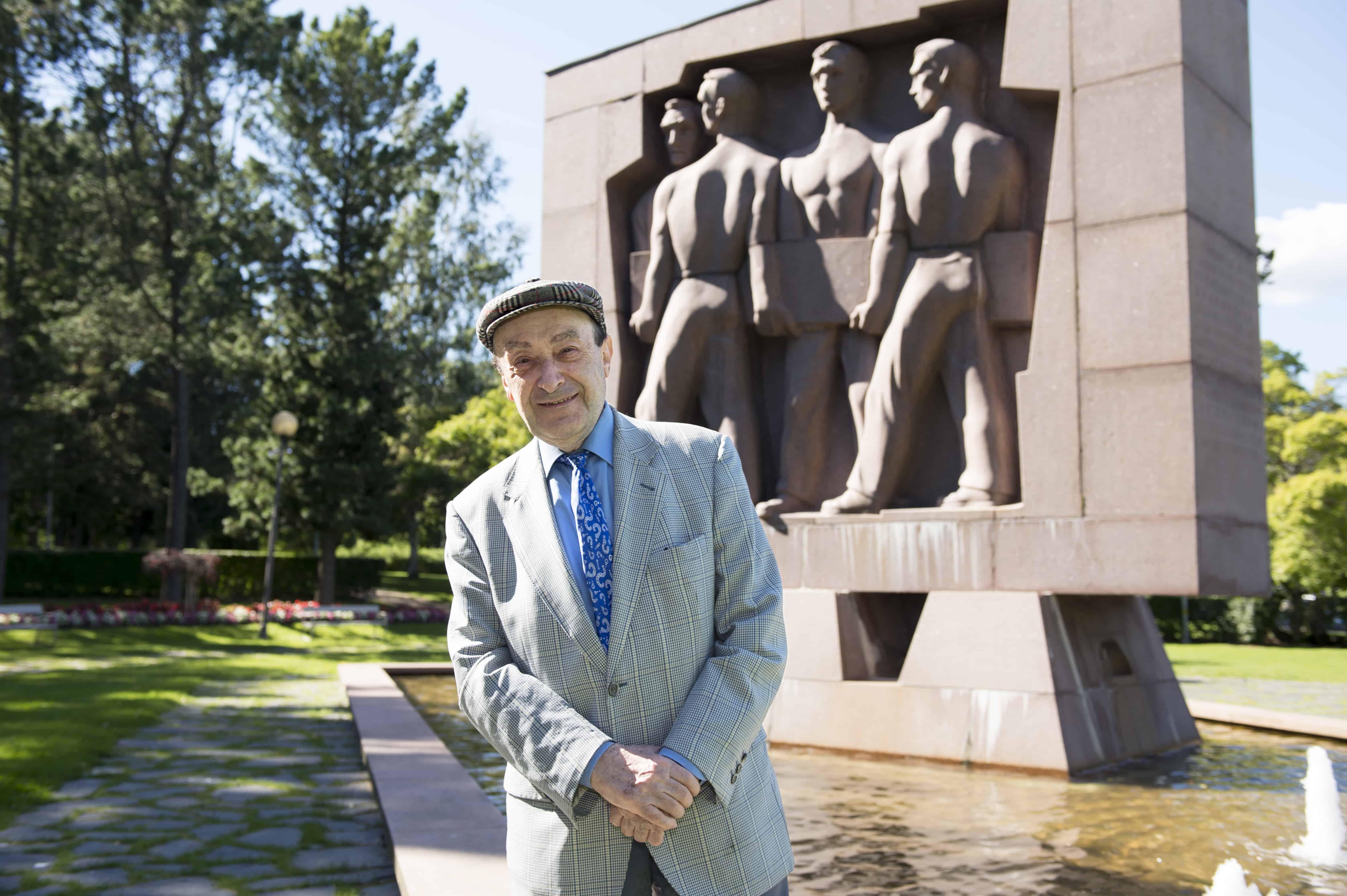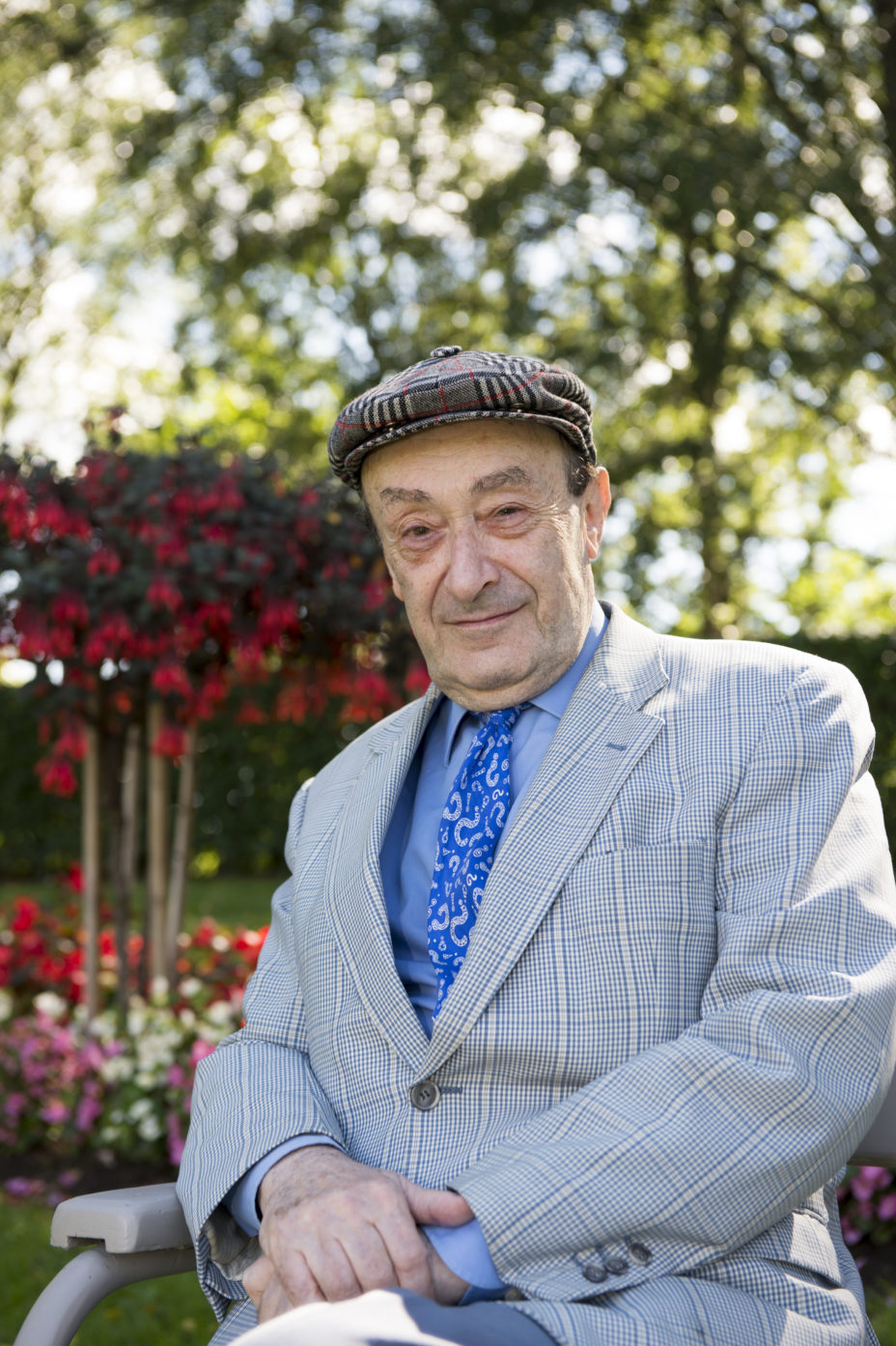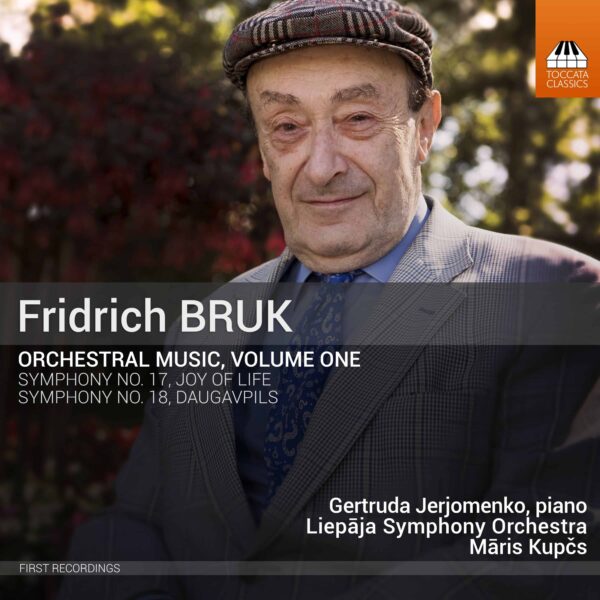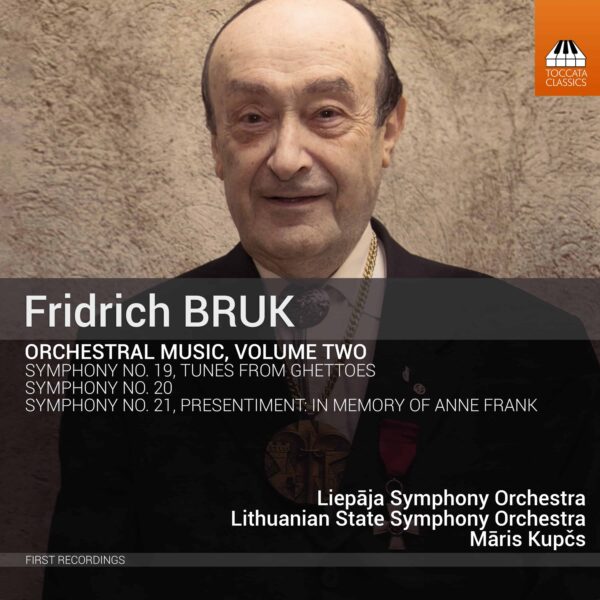Having traversed the symphonies of Robert Keeley in Part One of this brief survey (Too Many Symphonies – Part One – posted on 9 March 2021), it is time to turn to another composer frequently heard here in my Tooting listening booth: Fridrich Bruk. Born in 1937 in Kharkov (then part of the USSR, now part of Ukraine), Bruk moved to Finland in 1974. Rather like the composer-pianist Ronald Stevenson (1928–2015), English-born but a domiciled Scot, Bruk has made the history and culture of his adopted country central to his artistic concerns. Toccata Classics has released a straight flush of symphonies – Nos. 17, 18, 19, 20 and 21 – spread over two separate CDs. 1 Earlier symphonies can be sampled on other labels and some of these recordings are also on YouTube. It’s therefore possible to engage in a ‘total immersion’ of Bruk’s orchestral work – and what an odyssey it is! To discuss all Bruk’s symphonies would require a separate monograph but I offer you here a whistle-stop tour.
The fact that Bruk was 61 when his First Symphony was completed might make him one of the latest symphonic starters in music history – perhaps only second to Minna Keal, whose Symphony, Op. 3, was completed in 1988 when she was 79. 2 The First Symphony of Bruk is a programmatic exploration of events in the Finnish Civil War of 1918. The music is almost relentlessly dark and has at its apex a terrifying depiction of the executions that took place at Pyynikki Park in Tampere, where Bruk now lives. Throughout the symphony a solo trombone gives the music a narrative thread – it is almost as if it were uttering a protest song without words to the extremes of violence perpetrated by both sides in the conflict. Much of the music is hemmed in by insistent march rhythms – brass instruments in parallel sevenths or ninths add to the baleful effect – which might suggest those of Mahler but are to my ear closer to those that batter some of the symphonies of Erwin Schulhoff. By the end of the work there is a striving towards an uneasy peace; no empty triumph is achieved.
The Second Symphony (1999) is a large-scale composition positively seething with invention. In the long first movement the orchestra moves in vast blocks of sound before giving way to febrile contrapuntal passages where a virtuosic xylophone often plays a vivid role. 3 A solo piano enters part way through the second movement, which, whilst scherzo-like, is far from traditionally constituted as such – rather, the music presents a montage of ideas that wheel and dart, and in which the piano might be a kind of ringmaster. Towards the end, there is a ‘big tune’ over a cascading piano part, but the harmonies distort so as to magnify a bitter irony: Richard Addinsell on spoiled rations. The finale is broader in tempo choices and allows the piano to come to the fore as a lyrical protagonist. The whole piece qualifies for that epithet so beloved of the sleeve-note writers of Melodiya’s records of Soviet symphonies: ‘epic’. However, rather more to the point, it is worth considering a biographical detail in the case of this work: it is dedicated to Bruk’s mother, a fine concert pianist, who died in 1943 during the Second World War. The rebarbative tone of the symphony, far from evoking a fond recollection of motherly love, more likely reflects the circumstances of Ada Bragilevsky-Bruk’s death. She was one of many who died from malaria as a result of what is thought to have been a deliberate form of biological warfare perpetrated by the Nazis through their release of tropical mosquitos. 4
Skipping forward to the Fifth Symphony, In the Jewish Mode (2002), one finds Bruk engaging with a distinctively voiced Jewish heritage; the folk-like characteristics of Klezmer are evoked in a work of paradoxically loose but symphonic structure. The scenic qualities of the music perhaps reflect his time at the Lennauchfilm Studio in Leningrad – he began his tenure there in 1964 – yet there is a through-composed thrust that recalls Shostakovich’s Fourth Symphony in its musical working, if not in its sound-world. Bruk’s life has been coloured by his ethnicity and geographical location; his life in Finland, for example, has led him to a deep involvement in Finnish, Vepsian and Karelian folklore. A composition that shows a thoroughly fresh approach to Karelian folksongs is Bruk’s Ninth Symphony, subtitled Suomalaisessa vireessä, which translates as ‘In the Finnish Mood’. Strictly speaking, the inspiration is from Karelian folk-tradition: Bruk was in Karelia at the very start of his career as a composer in 1961. Here one hears him working largely in chamber textures; despite the significant body of instruments available, there is a sparing use of the massive tutti blocks of earlier symphonies. The mood is also largely free of the resultant dissonance of frantic counterpoint; an open-air feel gives buoyancy to textures and tonally inflected harmonies. In choosing what he calls Karelian ‘choir songs’, Bruk has found a way of transcribing the essential euphony of choral folk-singing into an orchestral context. His orchestration throughout is highly original and features percussion parts that contribute important melodic material more often than colouristic punctuation; it is the tubular bells that announce the radiant coda to the Ninth Symphony, crowning it with shimmering overtones.
The propensity for chamber-like textures, clearly voiced harmonies and the melodic use of percussion are characteristics much to the fore in the five symphonies recorded by Toccata Classics. There are outbursts from the orchestra at full throttle, but they stand in ever-starker relief by being surrounded by cooler, sparser textures. Symphony No. 17, Joy of Life, a rarity in that it has a glockenspiel announcing the first theme, presents an ever-evolving set of ideas. A solo piano, as in the Second Symphony, is a protagonist in an often propulsive drama. The second of three movements is delicately revealing – fragile ideas strive towards a lyrical release which the piano provides in passages of aching nostalgia, a solace to be valued all the more for its scarcity in Bruk’s music. It should be said that the subtitle Joy of Life does not suggest a one-sided portrayal of a blessed existence; rather, the composer seeks to present a life shot through with expressive variety. Sometimes the allusions are fleeting: a poème of yearning suggestive of Skryabin, a militaristic outburst, a snatch of Yiddish folk-music, a rage gathered in an orchestral fist – as though memories are overlapping and reconfiguring themselves.
Listeners in need of a balm of magical evocation need look no further than Bruk’s Symphony No. 18, Daugavpils. The purveyor of magic is the kokle, a Latvian folk instrument from the Baltic zither family: it shimmers its way through the symphony like a veil passed across a field of vision. Misty recollections of halcyon days? A Latvian twilight? Not quite. The beautiful mirage, as beguiling as that of Celtic provenance so memorably countenanced in W. B. Yeats’ poetry, is subjected to searing interruptions, thereby setting up a violent disjunct between a feeling of love for one’s homeland and its violent dismemberment. The subtitle Daugavpils refers to the Latvian birthplace of Bruk’s father, Michael, from which he and his entire family were forcibly expelled as part of a mass deportation of Jews to Kharkov, Russia, in 1917. Seen in this context, the sound of the kokle is a memory tinged with pain and exile. It is instructive to place Bruk’s writing for the kokle alongside traditional writing for Celtic harps: the Welsh telyn deires (triple harp), the Irish cláirseach and the Scottish clàrsach. As so often with Bruk, folksong acts as a springboard for memory, yet the way melodies are dislocated from mere nostalgia renders them an unstable bulwark against the forces arrayed against them. In the second of the three movements of No. 18, Latvian and Jewish colours are mixed. The symphony ends with an original theme and five variations, the last of which brings the kokle very much to the fore, so as to suggest the ineradicable power of cultural memory: a hopeful ending to close a deeply conflicted symphony. Gertruda Jerjomenko is the excellent pianist in Symphony No. 17 and Anda Eglīte plays the kokle with fragile expressivity in No. 18. The collective artistry of the Liepāja Symphony Orchestra, conducted by Māris Kupčs, is highly sympathetic to Bruk’s music.
Symphonies Nos. 19, 20 and 21 can be said to form, in Tish Kennedy Davenport’s words, a ‘meta-symphony’, 5 since they form an arch whereby the central non-programmatic No. 20 is enclosed within Nos. 19 and 21, which reflect on Jewish culture and its attempted eradication by the Nazis. The first in this meta-symphony or symphonic sequence opens as if with the flourish of a curtain – a rising harp arpeggio and portentous brass chords – a lost Yiddish theatre coming to life again. The many folksongs used in the symphony as jumping-off points for free variations and metamorphoses are like characters on a stage filled with an almost forgotten but now renewed fervour. Like the First Symphony, with its trombone ‘narrator’, Symphony No. 19, Tunes from Ghettoes, has a solo instrument as a central protagonist, on this occasion a baritone saxophone; Bruk writes often convoluted lines for the soloist, so that its voice is sometimes an angry soliloquy, punctured by the orchestra acting as a hostile Greek chorus. The result is compelling – a singularly new way to present folksong – not in discrete parcels or ‘settings’ but as part of a web of ideas and associations shot through with Yiddish memorials, like a tattered, once beloved coat found in an attic. The threads survive. Symphony No. 20 is dedicated to Bruk’s wife, Nadezhda, to celebrate their 60th wedding anniversary. Here one finds him working with a small ensemble of clarinet, two trumpets, marimba, percussion and string orchestra. This instrumentation reveals his mastery of the restricted palette. His use of percussion, as so often with this composer, is predominantly melodic, although he is alive to colouristic usage. This symphony has the quality of an eighteenth-century divertimento – indeed, it could fit perfectly in a concert of such pieces by Mozart and Bartók. Bruk accesses a sunnier landscape here, which acts as respite from the tragic weight of the surrounding works in the medium.
The spectral way with which Bruk begins his Symphony No. 21, Presentiment: In memory of Anne Frank (1929–1945), evokes a world of repression, oppression and sheer terror: an eldritch net of sound through which a lonely alto flute strives for expression. The harmonies are redolent of Bruk’s earlier ‘epic’ style, yet are somehow laid bare by the acuteness of feeling involved – as if these knots of sound can be unravelled to reveal a chink of light – that single light of Anne Frank’s voice, perilously glimmered before annihilation. The music brings no consoling remembrance. Bruk makes us look – in the way that Joseph Conrad intended we should – upon atrocity in action in all its dire, uniformed pomp and banal directives. At its end the symphony parades strangled trumpet fanfares and a kind of bone-dance of bongos – almost like a child’s depiction of hell. Like the rocking horse at the end of Berg’s Wozzeck, the bongos hint at the bitter taste of death taking place off-stage. This is a work of deeply concentrated emotion – it might be termed ‘condensed epic’ – coupled to an unerring skill in presentation. Bruk’s Symphony No. 21 takes its place alongside such Anne Frank-inspired compositions as the stand-alone extract, Elegy for Anne Frank, from the Third Symphony of Lukas Foss (1989), and Grigori Frid’s opera Dnevnik Anny Frank (‘The Diary of Anne Frank’; 1968). The fine baritone saxophonist in Symphony No. 19 is Arvydas Kazlauskas. Once again, Māris Kupčs conducts the Liepāja Symphony Orchestra, with the Lithuanian State Symphony Orchestra doing the honours for Symphony No. 20.
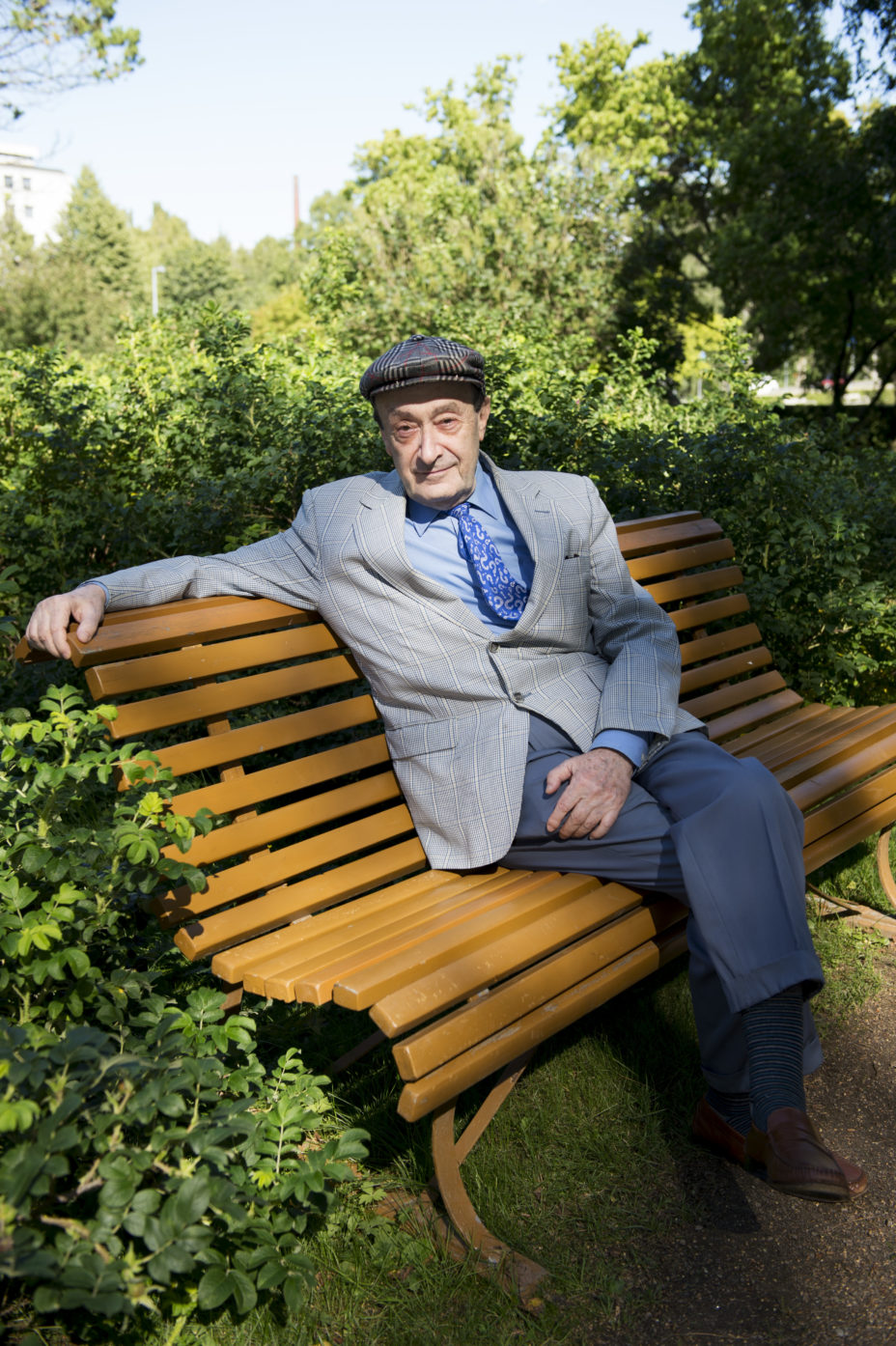
© Minna Jaalovaara
Bruk has found his own sound-world and it is all the more distinctive for owing little to the prevailing models of Shostakovich or Prokofiev, so ubiquitous for Soviet-trained composers of the preceding generation and his own. In this sense he is an outlier similar to Gavril Popov, Mikhaïl Nosyrev or Edison Denisov. The ease with which Bruk can pivot on an eclectic mix of references might remind some listeners of Alfred Schnittke – like that master of polystylism, Bruk has very big ears; his music can run the gamut from crunching dissonant blocks in the manner of Nosyrev to the most sensuous of dance-rhythms. In the latter context it should be mentioned that Bruk has had considerable success as a composer of tangos – a popular, social dance form in Finland – and Bruk admits all his experience in this and other fields into his symphonies. The compositional mind can be a receptive dish for all sorts of signals; it can wander through history and memory landscapes, picking up threads like a psychogeographer. I feel Bruk walking the territory in sound. His dedication to the symphony as a viable arena for the deployment of orchestral forces on a large scale is all the more remarkable since his 23 symphonies to date have been composed in the space of only 23 years; one thinks of Nikolai Miaskovsky, Mieszysław Weinberg and Havergal Brian as worthy stablemates in the compulsion to write works in this form. Furthermore, Bruk’s is an art dedicated to the revelation of the fault lines of cultural and social conflict; it is unflinching in its approach to the tragedies of the not too distant past. That these fault lines seem ever-renewable by those greedy for the acquisition and manipulation of power make Bruk’s music both a vital record of past damage and a warning for the future.
Epilogue: Untidy Lawns
In music I am sure what is needed are multiple voices; creativity harnessed for freer flights than textbooks or cultural gatekeepers would allow. We might even want excess. Historians of poetry are aware of Eric Homberger’s telling phrase, ‘Balkanised literary context’, 6 which he uses when describing the various scenes of poetic action that seemed to come to fruition in the 1960s and 1970s – those of ‘Liverpool, Newcastle, New York, the Pacific North West, and the Heartland of the Midwest’. 7 All this plurality at around the same time as Harrison Birtwistle’s Punch and Judy was driving amateurs of more genteel tastes from the strand at Aldeburgh, and the ever-lamented David Munrow was revealing the equally startling sound of ancient music from his cricket bag of racketts, shawms and bladder pipes. No doubt factionalism has played its role in seeing this ‘Balkanisation’ as expressive of antagonistic groups – and yet the sheer personalities of individual voices can and should overcome that which may be desired by official organs of prevailing artistic certainty and do so without smashing past endeavour. What is certain? If the answer is ‘nothing’, then we may be in trouble or merely indifferent; one purpose of art is to keep the question airborne long enough to voice possible answers, even if an ill wind flings them back in disdain. We should not sacrifice those voices on the tidy lawns of the parochial, nor should we plough entirely the grass with the rough chariot of Pluto. Composers like Rob Keeley and Fridrich Bruk, able to look both ways on the path of history, are essentially generous of heart and mind, their works offering musical answers, perhaps, but also leading the mind outwards to shapes, colours, landscapes and peoples. That they choose the symphony as a medium for serious musical thought and public statement is to be celebrated for showing that form to be an ever-valid one for such endeavours.
1 Recorded by Toccata Classics on TOCC 0455 (Symphonies Nos. 17 and 18) and TOCC 0543 (Symphonies Nos. 19, 20 and 21).
2 Justin Connolly (1933–2020), who became Minna Keal’s teacher when she was in her mid-sixties, started his own first essay in symphonic form at the age of 87; alas, only sketches of it survive.
3 Xylophone spotters will note kinship with the scherzo of Havergal Brian’s Gothic Symphony.
4 Further details can be found in the excellent booklet notes written by Tish Kennedy Davenport for both Toccata Classics releases.
5 Booklet accompanying TOCC 0543.
6 Eric Homberger, The Art of the Real: Poetry in England and America since 1939, J. M. Dent & Sons, London and Toronto/Rowman and Littlefield, Totowa, New Jersey, 1977, p. ix.
7 Ibid., p. 179.
